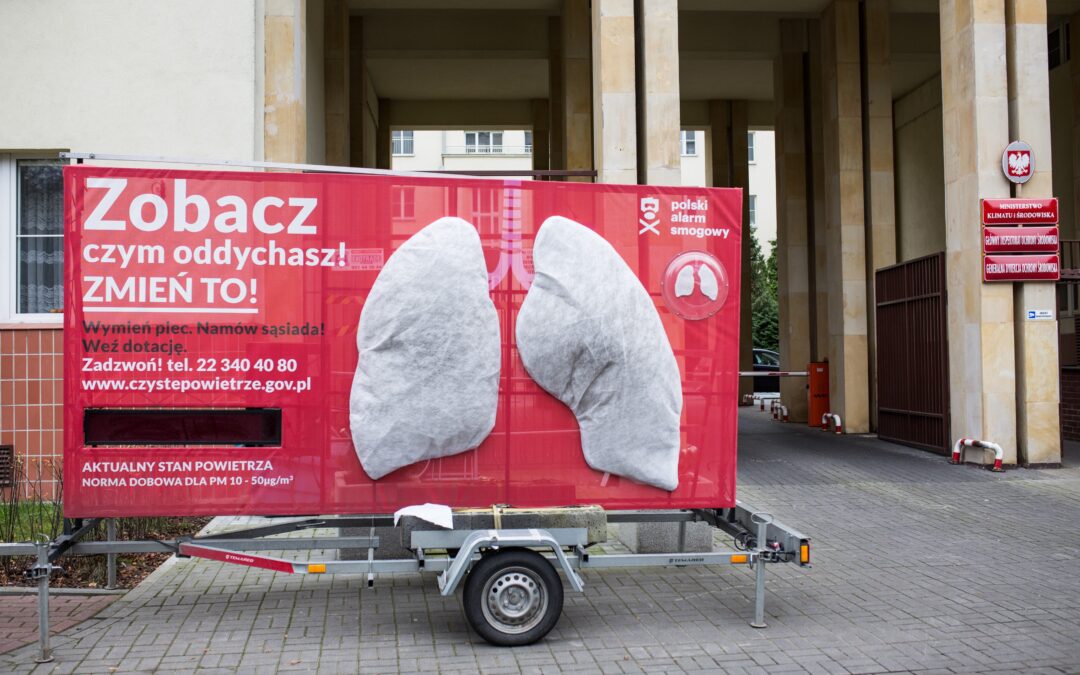Giant “breathing” lung installations will tour 18 Polish towns and cities over the next four months to show residents how much pollution they are inhaling on a daily basis.
The “See What You Breathe” campaign, launched by Polish Smog Alert on the eve of Clean Air Day, features three mobile lung installations designed to show the effects of air pollution.
Ventilators at the back of each model allow air to pass into the lungs, which then change colour as air pollutants are deposited on the material. The campaign is an expanded version of last year’s first edition, when one lung model toured five towns in southern Poland as well as visiting Warsaw.
Polski Alarm Smogowy startuje z kampanią “Zobacz czym oddychasz”. W wybranych miejscowościach pojawią się sztuczne płuca, pokazujące stan jakości powietrza. Pierwsze instalacje można zobaczyć w Otwocku, Krzeszowicach i Jeleniej Górze.#powietrze #smog https://t.co/CPHiMlMuaM
— SmogLab (@SmogLab) November 13, 2020
Poland has long struggled with some of the worst air pollution in Europe, which causes 47,500 premature deaths annually, according to the European Environment Agency. Recent years have seen grassroots initiatives to improve air quality, and the government has responded with initiatives including its flagship “Clean Air” programme launched in 2018. But these have been beset by difficulties, with poor implementation blamed for a low uptake.
According to Polish Smog Alert, a social movement, the “See What You Breathe” campaign aims to draw attention to the hidden consequences of Poland’s pollution problem, as well as encourage the replacement of old boilers.
“Air pollution is very often invisible and therefore ignored,” said spokesman Piotr Siergiej, quoted by RMF24.
“We created a two-metre model of human lungs on our installation, covered with white semi-permeable fabric. After some time, air pollutants begin to deposit on the white material. Pollution enters our lungs in a similar way,” he added.
As well as a visual reminder of the effects of pollution, a sensor on the billboard will show the concentration of PM10 in a given hour.
During last year’s campaign, in some towns across the coal heartlands of Poland’s south, the lungs turned grey within days of their installation.
This year’s edition will take the model to destinations in five provinces: Małopolska (Lesser Poland), Silesia, Lower Silesia, Mazovia and Pomerania. According to World Health Organisation data, small and medium-sized towns are often the main culprits for high pollution levels in Poland. Smog here largely comes from residents burning low-quality coal and wood, the main heating fuels for over four million Polish homes.
In August, the Air Quality Life Index (AQLI) found Poland to have the worst air in Europe. The AQLI considers how air pollution concentrations affects human life expectancy, revealing that life expectancy for inhabitants of two Polish cities, Warsaw and Łódź, would rise by 1.2 years if steps were taken to reduce pollution.
Poland’s “Clean Air” programme, which is theoretically the largest such programme of its kind in Europe, aimed to tackle smog by providing households with funds to replace old heaters and to improve insulation.
However, the initiative has not had the expected impact. Insufficient implementation and limited public interest led the European Commission to last year consider withdrawing funding for the programme, according to Euractiv, with reports that Poles living in rural communities had particular difficulties in accessing funds.
Polish Smog Alert said the programme was “not working at the expected pace”, reports RMF24.
In September, the government moved to close a loophole that had previously left many excluded from the initiative, with poorer households made eligible to obtain additional state financing.
Meanwhile, many cities have taken the initiative to battle smog. Kraków, which has been notorious for its bad air in recent years and where Polish Smog Alert started, has been a pioneer last year in such initiatives. Last year, it became the first place in Poland to ban the burning of coal and wood.
Other campaigns have also been launched to raise awareness of pollution in Poland. Murals, drawn using jets of water, have recently appeared on the dirty facades of buildings in Warsaw as part of a campaign by energy company Innogy Polska to show how smog affects health, reports Gazeta.pl.
“We can see how polluted the air we breathe in the city is by looking at the buildings in the capital,” Sebastian Janda, an Innogy director, told Wirtualne Media.
“Their facades turn grey with smog every day. Although we do not see the pollutants we breathe on a daily basis, they settle on buildings creating a visible trace.”
Main image credit: Adam Stępień/Agencja Gazeta

Juliette Bretan is a freelance journalist covering Polish and Eastern European current affairs and culture. Her work has featured on the BBC World Service, and in CityMetric, The Independent, Ozy, New Eastern Europe and Culture.pl.




















